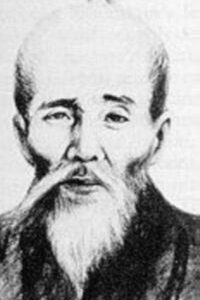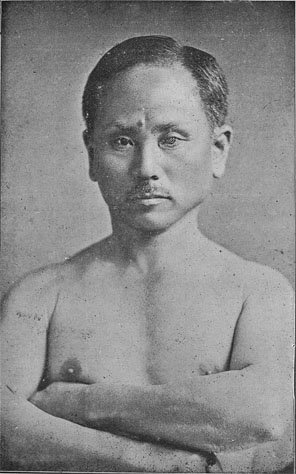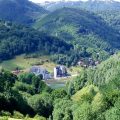The Evidence That Master Seisho Aragaki
Taught Master Gichin Funakoshi
 I read in an article that Master Gichin Funakoshi was taught by Master Seisho Aragaki, in addition to the various other masters
I read in an article that Master Gichin Funakoshi was taught by Master Seisho Aragaki, in addition to the various other masters
who Funakoshi listed to have instructed him. The source, which I cannot recall now, did not state support of the allegation in any capacity. So I thought that it may simply be an error, as is so often seen, from the person who might claim to be an author or writer, or even researcher, based on reading the English edition of Master Funakoshi’s text, “Karate-Do: My Way of Life”, noting the name “Master Niigaki”, and simply presuming that name to actually be “Aragaki”. However, the other day I thought to search for the name “Niigaki” in “Jeffrey’s Japanese to English Dictionary Server” (which is a very good source for Japanese language), and check the ideograms used to write the name “Niigaki”, if they appeared in the search, with the characters used to write the “Aragaki” of Master Seisho Aragaki. Simply reading the English pronunciation of what started as Chinese symbols is not the best way to know for certain if, in this case, the name is meant to be, or could be, different, even if it would be a case of that difference merely being down to the existence of various alternatives of the verbalising of the name in question. And this has turned out to indeed be the case. The rule really is to check the oriental characters used, for yourself, because even when the manuscript has been very accurately and articulately translated, as with the English edition of “Karate-Do: My Way of Life”, there can still be issues on the simple basis of the choice of translation made by the particular translator at the time, which may have differed at either a different time or if made by a different translator.
So, it is evident that the names “Niigaki” and “Aragaki” are the same, since the characters used for their true writing are the same in both cases. And then, based on comparison with some other Aragaki’s noted as karate-men, regarding their respective dates of birth (and death), and in relation to the similarities between Master Funakoshi’s niseshi and unsu kata, and Master Mabuni’s niseshi and unsu kata (with sochin differing on account of Funakoshi having perpetuated his version of Kudaka sochin, as is clear when compared with the illustrations of Kudaka sochin in the book “Essential Shorinji Ryu karate-do” by Masayuki Hisataka), and with the important point that it is noted (by Patrick McCarthy in volume two of the text “Ancient Okinawan Martial Arts”) that Mabuni learnt (regarding karate kenpo only, and not worrying about kobujutsu in this article) niseshi and unsu, and re-learnt sochin, from Master Seisho Aragaki who corrected Mabuni’s version of sochin which he apparently learnt from Master Itosu, (It makes sense that Itosu could have known at least a similar version, on account of his lineage linking to either the Chinese Zhaoling quanfa master called Ason, or Master Waishinzan, also of Zhaoling quan {Shorei-ryu kenpo}, each being noted as a teacher of Master Nagahama, Ason in “Rentan Goshin Karate Jutsu”, and Waishinzan in “Karate-Do: Kyohan”, both by Master Gichin Funakoshi.
 Whichever is correct, unless they both instructed Nagahama {who was a teacher of Itosu}, there is a definite link to Shorei-ryu kenpo {though that in itself does not mean that Itosu must have known a version of sochin kata}.Seisho Aragaki {and Norisato Nakaima, who is relevant because Ryuei Ryu karate includes a version of niseshi which bears similarities to Aragaki niseshi, though is also notably different} learnt from Master Waishinzan {as well as Master Ru Ruko}.), Funakoshi perhaps studied the set of kata from Itosu, but must have at least also learnt them (whether sochin was included or not) from Aragaki, as they were Aragaki’s noted and perpetuated speciality, aside from his knowledge of kobujutsu. That would prove Funakoshi’s niseshi and unsu to be of Aragaki’s lineage, slightly altered (perhaps by Master Gichin Funakoshi, yet there is a version of unsu that was uploaded online by Juan Beltran Rodriguez which is more alike Funakoshi’s than Mabuni’s!), but very similar to Mabuni’s versions, which would suggest that they are at least close to Aragaki’s originals, if these two lineages teach some similar kata as they do, like the version of sesan which Funakoshi perpetuated, the origins of which can be supported by the kata’s existence in similar form within Mabuni Shito Ryu. Additionally, Master Hironori Otsuka’s niseshi performance further reinforces my overall point, since his kata were a combination of Funakoshi karate and Mabuni karate, evidently for the vast majority.
Whichever is correct, unless they both instructed Nagahama {who was a teacher of Itosu}, there is a definite link to Shorei-ryu kenpo {though that in itself does not mean that Itosu must have known a version of sochin kata}.Seisho Aragaki {and Norisato Nakaima, who is relevant because Ryuei Ryu karate includes a version of niseshi which bears similarities to Aragaki niseshi, though is also notably different} learnt from Master Waishinzan {as well as Master Ru Ruko}.), Funakoshi perhaps studied the set of kata from Itosu, but must have at least also learnt them (whether sochin was included or not) from Aragaki, as they were Aragaki’s noted and perpetuated speciality, aside from his knowledge of kobujutsu. That would prove Funakoshi’s niseshi and unsu to be of Aragaki’s lineage, slightly altered (perhaps by Master Gichin Funakoshi, yet there is a version of unsu that was uploaded online by Juan Beltran Rodriguez which is more alike Funakoshi’s than Mabuni’s!), but very similar to Mabuni’s versions, which would suggest that they are at least close to Aragaki’s originals, if these two lineages teach some similar kata as they do, like the version of sesan which Funakoshi perpetuated, the origins of which can be supported by the kata’s existence in similar form within Mabuni Shito Ryu. Additionally, Master Hironori Otsuka’s niseshi performance further reinforces my overall point, since his kata were a combination of Funakoshi karate and Mabuni karate, evidently for the vast majority.
I must note that Sensei Patrick McCarthy has at least mentioned Funakoshi to have been taught by Aragaki in an article published on his blog for his organisation, International Ryukyu Karate Research Society, which was about Master Seisho Aragaki. I am not the first to note this point, and I may not be the first to know of, or provide, evidence. Nonetheless, the supporting documentation, if you will, is detailed here in this article, to solidify the claim of Seisho Aragaki’s teaching of Gichin Funakoshi, from the founding basis written by Funakoshi in “Karate-Do: My Way of Life”. Therefore, it is certainly not some groundbreaking note. It originates from the name chosen for Aragaki for the English translation of the aforementioned book, happening to differ from writing “Aragaki”. Had that not been the case, there would not have been an issue for later discussion all these years down the road.
I would note that Master Yuchoku Higa taught sochin and unsu, and that his sochin is very similar to Mabuni’s, though not identical. Kyudokan unsu, on the other hand, is completely different. (Mark Bishop noted in his second edition of “Okinawan Karate” that Master Higa learnt Aragaki sochin from a certain Master Akamine, and niseshi from a Master Kokuba, but that he taught neither of these forms. Though this text was published in 1999, it must be pointed out, since there is not yet a third edition, that evidently sochin was taught, and that a version of unsu was, too, though niseshi appears to have not been transmitted by Higa. I would add, however, that Mr Bishop’s book is an excellent manuscript, regardless of this point.) Higa’s differing version of sochin does at least further prove (like with Ryuei Ryu, similarly, for niseshi) there to be variations of the same kata Seisho Aragaki transmitted, supporting the note of Aragaki only correcting Mabuni’s sochin (though he taught niseshi and unsu to Mabuni, additionally). Sometimes not all the kata taught by a master were passed on to this or that person, so Nakaima only learnt niseshi, apparently, and Higaonna only learnt sanchin and sesan from Aragaki, it would seem (unless he chose to forget the others). Nakaima’s niseshi is quite similar to Aragaki’s, as previously mentioned, so it must have similar lineage, which is supported with evidence of their respective lines of transmission linking to Masters Waishinzan and Ru Ruko (again, as already noted). Whoever changed the kata, whether in China by a Chinese, or otherwise, sochin could have been the only one of the three which are a set for Aragaki’s line, that Itosu knew, as is true for the kata of Kudaka lineage (regarding sochin) and the niseshi that Master Nakaima transmitted in his school which later became known as Ryuei Ryu, as well as Master Otsuka being affected in the same way, only learning one of the three kata. They do not always have to remain as a set, and clearly did not.
Sean R. Marshall



Leave a Reply
You must be logged in to post a comment.